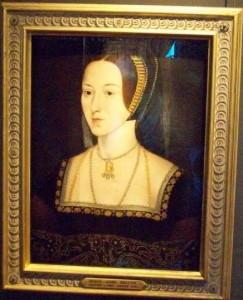
On the 1st June 1533, Whit Sunday, a pregnant Anne Boleyn was crowned Queen at a ceremony at Westminster Abbey. Anne was dressed in ermine trimmed purple velvet coronation robes and had a gold coronet on her head as she joined the procession assembled at Westminster Hall just before 9am. How beautiful she must have looked with her dark hair and purple robes as she walked under the golden canopy of the Cinque Ports!
The Ceremony
Eric Ives gives a vivid description of her coronation ceremony in his book “The Life and Death of Anne Boleyn”1. He writes of how the 700 yard route between the dais of the hall and the abbey high altar was carpeted with cloth of blue ray and how everyone – monks, Lord Mayor, aldermen, judges, staff of the Royal Chapel, bishops, archbishops and abbots – were in their very finest robes.
As Anne processed behind the sceptre of gold, the dove topped rod of ivory and the Lord Great Chamberlain (the Earl of Oxford) who bore the crown of St Edward, she was followed by the bishops of London and Winchester, ladies and gentlewomen all dressed in scarlet, and her train was carried by the Dowager Duchess of Norfolk. This procession was watched secretly by the King, who hid behind a lattice screen in a special stand. How proud he must have been.
After the procession, Ives writes of how Anne rested for a moment on the gold draped St Edward’s Chair, situated on a dais covered in tapestries, before she moved on. Anne then prostrated herself (not an easy thing to do when you’re pregnant!) before the altar and Archbishop Thomas Cranmer prayed over her and then anointed her before she made her way back to St Edward’s Chair where he crowned her with the crown of St Edward, which had previously only been used for crowning the reigning monarch. Cranmer also handed Anne the sceptre and the rod. Anne was now the crowned Queen of England, what a relief!
The Te Deum was then sung and Anne was able to swap the heavy St Edward’s crown for a lighter one before she took the sacrament and gave the customary offering at the saint’s shrine. The service was now over and Anne was able to get some fresh air and refreshment before processing back into Westminster Hall, via New Palace Yard with its cisterns running with wine. However, this was not the end of the rituals and celebration for an exhausted Anne, she also had to attend her coronation banquet in Westminster Hall.
The Coronation Banquet
Ives describes Westminster Hall on that day:-
“The judges had been turned out days before, their courts dismantled, the windows reglazed, the seating and statuary gilded, and the hall hung with arras for the occasion.”2
I’m wondering if we’d need sunglasses if we went back in time, with all that gilding!
Anne sat on the King’s marble chair (luckily it had been lined with a more comfortable inner chair with the Archbishop of Canterbury at a long marble table under the cloth of estate. She was attended by the Dowager Countess of Oxford and the Countess of Worcester, who stood beside her, and two gentlewomen at her feet. Her husband, the King, accompanied by the ambassador of France and Venice, watched the banquet from a special purpose built high box. The Duke of Suffolk, who, as high steward, was in charge of the event, sat on a crimson velvet draped horse and wore “a doublet and jacket dripping with pearls” – wow!
As for the meal, this is what Ives has to say:-
“Suffolk and Howard now escorted in the first course, twenty-eight dishes for the queen and the archbishop, which were carried by the new Knights of the Bath. Twenty-four dishes followed for the second course and thirty for the third – each heralded with as much noise as the king’s trumpets and minstrels could make – and even though the lower tables had fewer dishes, according to a carefully graded scale, the lord mayor and his companions were very satisfied with their two courses of thirty-two… the lavishness and magnificence of the food… was set off by a profusion of “subtleties”, [inedible ornaments] those curious devices so beloved of the Burgundian tradition of royal feasting. The wax ships were singled out for particular praise.”3
I bet Henry VIII was pleased with the spectacle that was displayed before the eyes of the ambassadors! Again, he was sending a clear message that Anne Boleyn was his Queen.
Ives points out that even the banquet was not the end of the day for Anne, she then had to get through the closing ceremonies. I can only imagine her exhaustion at this point, both mental and physical, but this must have been mixed with joy and the feeling that she had finally made it, she had achieved her goal. Phew!
Notes and Sources
- The Life and Death of Anne Boleyn, Eric Ives – Chapter 12 “A Coronation and a Christening”
- Ibid., p179
- Ibid., p181